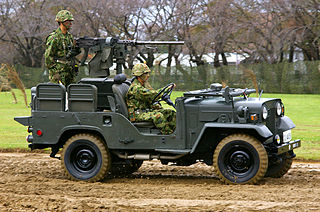
Komatsu Ltd. or Komatsu (コマツ) is a Japanese multinational corporation that manufactures construction, mining, forestry and military equipment, as well as diesel engines and industrial equipment like press machines, lasers and thermoelectric generators. Its headquarters are in Minato, Tokyo, Japan. The corporation was named after the city of Komatsu, Ishikawa Prefecture, where the company was founded in 1921. Worldwide, the Komatsu Group consists of Komatsu Ltd. and 258 other companies.

The LAV-25 is a member of the LAV II family. It is an eight-wheeled amphibious armored reconnaissance vehicle built by General Dynamics Land Systems and used by the United States Marine Corps and the United States Army.

The Type 01 LMAT is a Japanese man-portable fire-and-forget anti-tank missile. Development began in 1993 at Kawasaki Heavy Industries and was accepted into service in 2001. During development, the missile was designated with the codename XATM-5. Later it was known briefly as the: ATM-5.

The Type 87 Chū-MAT Chū-MAT is a Japanese laser guided anti-tank missile in service with the Japanese Ground Self-Defense Forces. Intended as a front-line replacement for the Type 64 MAT, it has entered into service alongside the SACLOS guided Type 79 Jyu-MAT.

The Type 79 Jyu-MAT is a Japanese SACLOS guided anti-tank missile that entered service with the JGSDF in 1984. It was initially issued to coastal defence units, intended to destroy troop and vehicle landing ships as they approached the shoreline. It is also known as KAM-9.

The Type 10 is a Japan fourth generation main battle tank produced by Mitsubishi Heavy Industries for the Japanese Ground Self Defense Force. It entered service in 2012. Compared with other currently-serving main battle tanks in the JGSDF, the Type 10 is better equipped to deal with anti-tank weapons.

The Mitsubishi Type 89 IFV(89 FV ) is a Japanese infantry fighting vehicle that entered service with the Japan Ground Self-Defense Force in 1989. There were 58 vehicles in service as of 1999 and a total of 120 produced by 2014 with 300 planned. The main armament of the vehicle is an Oerlikon Contraves 35 millimeter KDE cannon.

The Special Forces Group is the Japan Ground Self-Defense Force's special forces unit established on March 27, 2004.

The Howa Type 96 automatic grenade launcher (AGL) is a Japanese automatic grenade launcher made by Howa since 1996.

The Mitsubishi Type 73 light truck is a series of military light trucks that are used as mini SUVs in the JSDF. They have been under production by Mitsubishi Motors since 1973. In JSDF service, it is officially known as the 1/2 Ton Truck.

The Type 73 armored personnel carrier is a tracked armored personnel carrier that entered service with Japan Ground Self-Defense Force in 1973. In 1996, the JGSDF adopted the wheeled Type 96 armored personnel carrier to supplement the Type 73 and eventually replace it.

The Type 96 wheeled armored personnel carrier is an armoured vehicle that entered service with Japan in 1996, manufactured by Komatsu. This vehicle complements the existing fleet of tracked Type 73 armored personnel carriers already in service with plans to eventually replace it.

The Fahd is a 4x4 Egyptian armored personnel carrier, designed to fit the requirements of the Egyptian Military. It replaced older APCs in Egyptian service such as the BTR-40, and the Walid. It has been used by the United Nations.

The Type 16 maneuver combat vehicle is a wheeled armored fighting vehicle of the Japan Ground Self-Defense Force (JGSDF).

The Type 08 is a Chinese family of modern eight-wheeled, amphibious, modular armored vehicles developed by Norinco for infantry fire support, battlefield logistics, and quick reaction operations. Developed in the early 2000s, the vehicle family were produced for more than 6,000 hulls and widely deployed by the People's Liberation Army Ground Force and People's Liberation Army Marine Corps.

The Type 60 armoured personnel carrier is an armored personnel carrier that entered service with Japan Ground Self-Defense Force in 1960.

The Amphibious Rapid Deployment Brigade is a marine unit of the Japan Self-Defense Forces (JSDF) responsible for conducting amphibious operations.
The Light Armoured Vehicle (LAV) is a series of armoured vehicles built by General Dynamics Land Systems – Canada (GDLS-C), a London, Ontario-based subsidiary of General Dynamics. It is a license-produced version of the Mowag Piranha. The first generation of LAV was created by Mowag for the Armoured Vehicle General Purpose (AVGP) requirement of the Canadian Army. This was a 6x6 variant of the Piranha I produced by General Motors Diesel in London, Ontario. Since entering service in 1976, it has undergone a number of upgrades. The LAV II introduced the now-familiar 8x8 configuration. The LAV continues to form the backbone of the Canadian Army's combat vehicle fleet. The LAV series of vehicles exist in a number of different variants and are used in a number of different roles such as armoured personnel carriers, engineering vehicles, command posts, ambulances and armoured recovery vehicles.

The LAV 6, sometimes written as LAV 6.0 or LAV VI, is the fourth generation of LAV, and is based on the LAV III. The first vehicles were delivered in 2013 and after testing entered service in 2016. The Canadian Army plans to replace its entire LAV fleet of various LAV II and LAV III variants with the LAV 6. The vehicle is being acquired in two main variants: a fighting vehicle equipped with the 25mm cannon seen on the LAV II and LAV III, and a support variant labelled the Armoured Combat Support Vehicle (ACSV).
The Common Tactical Wheeled Vehicle (CTWV) is a family of wheeled armoured vehicles that are expected to be deployed by the Japan Ground Self-Defence Force. This vehicle is based on the same platform as the Type 16 manoeuvre combat vehicle, and four further variants have been developed, of which three will enter service.





















